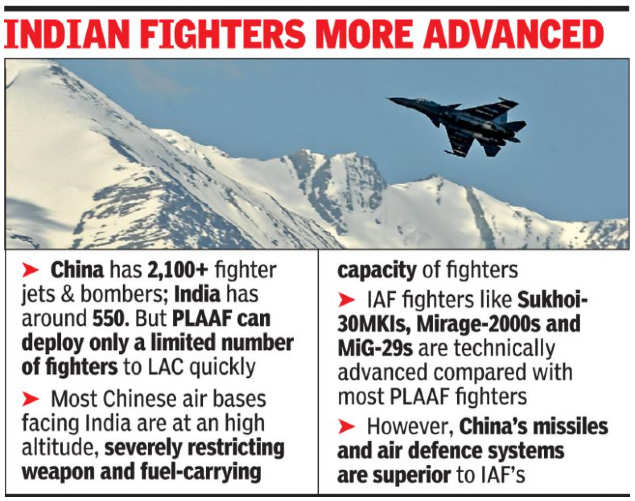IAF Watching Chinese Bases, Sure Of Matching Air Power

There has been “no major or fresh infusion of assets” by the People’s Liberation Army-Air Force at Hotan and Kashgar in Xinjiang as well as Gargunsa, Lhasa-Gonggar and Shigatse airbases said defence sources. But the Indian Army and IAF moved forward surface-to-air missiles and other such systems to tackle aerial threats
NEW DELHI: India is closely tracking Chinese air bases in Tibet and Xinjiang, which witnessed an initial build-up of fighters, bombers, drones and other aircraft as border tensions escalated on the ground, but is not too perturbed about air combat power along the LAC, with IAF seen to pack a solid operational punch.
There has been “no major or fresh infusion of assets” by the People’s Liberation Army-Air Force at Hotan and Kashgar in Xinjiang as well as Gargunsa, Lhasa-Gonggar and Shigatse airbases, some of which also function as civilian airfields, said defence sources. But the Indian Army and IAF, as part of their “total combat potential” deployed along the 3,488-km LAC after border skirmishes in Ladakh, moved forward surface-to-air missiles and other such systems to tackle aerial threats.
China’s Air Force Suffers From ‘Terrain Disadvantage’

Frontline Sukhoi-30MKI, MiG-29 and Jaguar fighters were earlier inducted into forward air bases, as was reported by TOI.
PLAAF does have four times the number of fighters and bombers as compared to IAF, but what will operationally matter is the actual number they can “throw at us” in the event of a conventional military conflict, said sources.
At present, the main Hotan airbase facing eastern Ladakh has around 35-40 J-11, J-8 and other fighters, along with a few AEW&C (airborne early-warning and control) aircraft and armed drones. Kashgar, in turn, has six to eight Xian H-6K bombers, with a sprinkling of fighters deployed in other airbases.
“Quantitatively, IAF can quickly deploy more fighters than PLAAF from its several airbases near the LAC to degrade China’s military capabilities on the ground,” said a source. More importantly, despite grappling with just 30 fighter squadrons when at least 42 are needed to tackle the collusive China-Pakistan threat, IAF also has a qualitative edge over PLAAF. The impending progressive induction of 36 Rafale fighters will further add to it.
PLAAF also suffers from a “terrain disadvantage” of high-altitude and rarefied air at its airbases facing India, which severely limits the weapon and fuel-carrying capacity of its fighters.



No comments:
Post a Comment